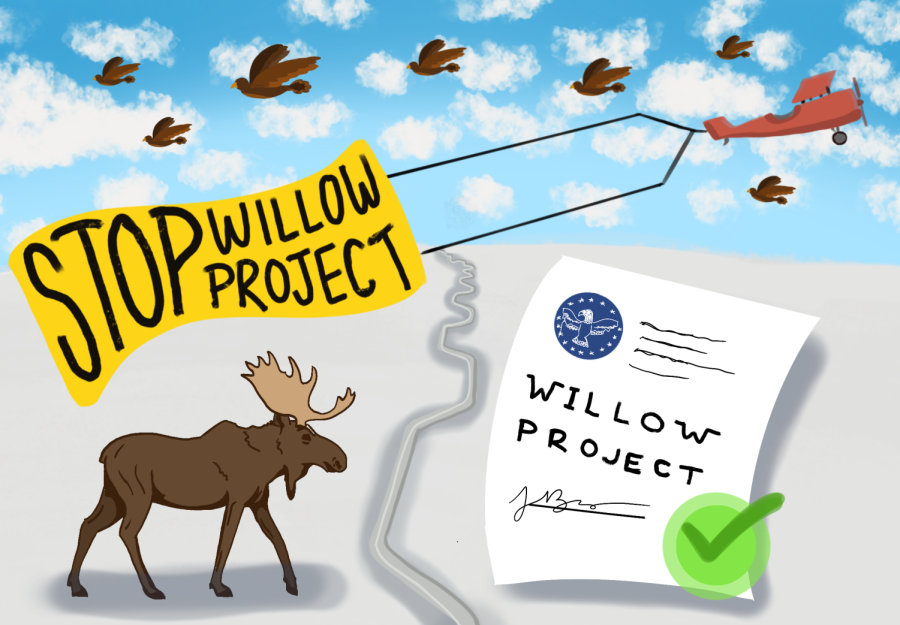What Is the Willow Project?
There are concerns about the Willow Project’s effects on the well-being of animals, their habitats, and their migration patterns.
April 5, 2023
On March 13, the Biden Administration announced that they have given the green light for the Willow Project, which began planning in 2018. The approval of the project has left some upset about its possible negative effects and others excited about its possible benefits. Here are some answers to frequently asked questions about the Willow Project:
What is the Willow Project?
The Willow Project is an oil drilling project that will cost $8 billion and — once up and running in Alaska’s National Petroleum Reserve — could extract almost 600 million barrels of oil over the next 30 years.
Who is behind the Willow Project?
Although it was initially approved by the Trump administration in 2020 and later approved by the Biden administration in 2023, the project was created by the company ConocoPhillips — Alaska’s largest crude oil producer.
Why did the Biden administration approve this project?
During his 2020 presidential election campaign, Biden emphasized his support for the environment saying, “No more drilling on federal lands, period. Period, period, period,” making his decision to approve the project a surprise for some of his supporters. That being said, there were a multitude of factors that led to his approval, including the global energy crisis, pressure from Alaskan lawmakers, the upcoming election year, and the desire to avoid a lawsuit from the ConocoPhillips Company.
Who and what will this project benefit?
Supporter of the Willow Project, Republican Senator Lisa Murkowski claims that the project could create 2,500 jobs and millions of dollars in revenue. Along with this, there would be less reliance on foreign oil and between eight and $17 billion in revenue that would go towards the federal government, Alaska, and North Slope Borough communities — the area located near the National Petroleum Reserve.
Who and what will this project negatively impact?
There are concerns about the project’s effects on the well-being of animals, their habitats, and their migration patterns. There is also quite a bit of concern about how the Willow Project could release greenhouse gasses and harm indigenous communities’ health, such as the Nuiqsut Tribe, who live near the drilling site.
Who supports the Willow Project and who doesn’t?
Those who support the project include Alaska lawmakers — who claim that getting oil this way will be a lot cleaner than getting oil from other countries — labor unions, the oil industry, and building trades. Those who are against the project include the environmental law group, Earthjustice. They’re expected to file a complaint and claim that the project is unlawful due to its potential environmental impact.
What is the public’s reaction to the project?
Although there are many people in support of the project, the Biden administration is also receiving a lot of backlash. During his campaign, Biden claimed to be environmentally friendly and expressed his desire to make investments in clean energy. His decision to approve the Willow project has some of his supporters feeling alienated and there is a likely chance that he will lose voters.
What are the reactions from members of the La Salle community?
“I would love to say I was surprised,” science teacher Mr. Ryan Kain said about the project’s approval. Although he is able to acknowledge some of the rationale behind the project because of factors such as economic impacts, he believes that this is not the direction to be moving in.
Senior Allie Ball, who heard about the project from a TikTok she came across, isn’t fond of the project’s approval either. “Honestly, I was really disappointed,” she said. “Just because Biden pledged a lot to try to combat climate change and then for him to go and pass this was really just disappointing and a sad reality.”
Focusing on the project’s potential impact on the environment, Mr. Kain and Ball both shared their concerns. “If we go in the trajectory that we’re going now, we’ll have irreversible damage — or past irreversible damage in the next 20 years,” Mr. Kain said.





